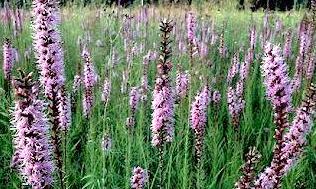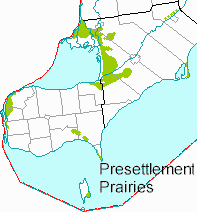
Ojibway Prairie Complex
Main Menu
Site Map
PRAIRIE LINKS
Tallgrass Prairie
in Southern Ontario

Many accounts of early Ontario stress the heavily- forested nature of the land, and created the image of vast, unbroken forest. Yet the early French explorers and first settlers of southwestern Ontario also discovered extensive, open landscapes. They encountered the outlying remnants of oak savanna and tallgrass prairie which once dominated a large portion of midwestern North America along the eastern edge of the Great Plains.
About 8,300 years ago, when the climate was warmer and drier than today, Leopold's "sea of prairie flowers" extended further east than it does today. A "prairie peninsula" extended from the Great Plains through Illinois and Indiana to Michigan, Ohio and into southern Ontario.
Gradually, the climate became slightly cooler and wetter which allowed for some re-invasion of forest, leaving the mosaic of prairie and savanna that were encountered by the first European explorers.
Prairie persisted where a combination of soil type, microclimate and fire continued to favour grasslands over forest. In southwestern Ontario, prairies are found where soils have limited capacity to store moisture. During spring the soil can be completely saturated yet by mid-summer soils become extremely dry. Periodic drought in the region enhances this effect. In general, the forests of eastern North America are less well adapted to moisture stress than prairie plants. Warm season prairie grasses such as Big Bluestem, Indian Grass and Prairie Cord Grass utilize a different photosynthetic pathway than our cool season lawn grasses which maximizes their growth in mid-summer when droughts are most likely to occur.

Fire caused by lightning or set deliberately by native aboriginals was important in maintaining prairie in Southwestern Ontario. Without periodic burning trees and shrubs will invade prairie causing a rapid transition to forest species. The significance of aboriginal-set fires is uncertain. Essex and Kent counties traditionally were the lands of the Central Algonkian people. Interestingly, the Huron name given to the first French explorers for the inhabitants of this southwest corner of the province was the "Fire Nation".
Then the settlers arrived. A description of the Detroit River in 1701 reads:
In 1791 the prairies of southwestern Ontario were still largely intact. At that time, Patrick McNiff wrote about Kent County bordering Lake St. Clair and the Thames River:

400 square kilometres of prairie still thrived in portions of Essex, Kent and Lambton Counties until the mid-1800's. In 1835 Patrick Shirreff passed through the area northwest of Chatham and described:
"an area between two and three miles wide, and as far as the eye could reach to the westward, destitute of trees, except for small spots here and there, bearing shrubs and stunted tress of various sizes, and which resembled islands in a lake. A number of dwarfish willows were growing in most places, and the grass consisted chiefly of two species, which occasionally reached the horses' ears. A number of beautiful flowering plants adorned the plains... The grass on much of this prairie is four feet high, and as thick as it can stand: no part of Illinois seems richer. "
But soon it began to quickly disappear. How much easier to plough the prairie, where mature trees average less than one tree per acre, or clear the savanna with its widely-scattered oaks than to cut down the heavy forest! Throughout its range, the tallgrass prairie was rapidly, inexorably destroyed.
Today, there remains less than two tenths of one percent of North America's original million square kilometers of tallgrass with less than 500 ha. in southern Ontario. In comparison, nearly 87 percent of Ontario's land is still forested.
The vestiges of the magnificent Kent County prairies exist as tiny clumps of Gray-headed Coneflowers or place names on maps, such as "Prairie Siding" and "Raleigh Plains". Dover Township, west of Chatham presents endless vistas of corn, wheat, soybeans and, thin, widely separated patches of trees. The scattered trees are sadly ironic, for in many places they are not remnants of a once great forest as often imagined, but grown-in prairie that once extended "as far as the eye could see". The beautiful prairies all but disappeared under the plow, and only recently, with increasing concern over nature in Ontario, have there been many people to mourn the loss and marshal an effort to save what is left.
Among the remnants that fortunately make Leopold's prediction not entirely true, are considerable stands of oak savanna and prairie on the Walpole Island Indian Reservation near Wallaceburg. And one can still stand in fields of prairie wildflowers in Windsor's collection of four parks within the former townsite of Ojibway. These parks are collectively known as the Ojibway Prairie Complex.
On warm, windy days in early spring, every few years, spectacular fires sweep through the thick mats of dry grasses on these prairies and savannas. Deliberately set, these fires remove the accumulation of ground litter allowing the soil to warm earlier in the year. Prairie plants are mostly warm season perennials which are dormant in April. The large, scattered oaks are sometimes scarred but seldom killed.
A visit to a prairie site on Walpole Island in mid May is breathtaking. By then, the black landscape of an April burn has been replaced by a carpet of Small White Lady's-slipper orchids, Golden Alexanders, Blue-eyed Grass Yellow Stargrass, Arrow-leaved Violet, Wood-betony and Hoary Puccoon. Unlike hardwood forests where the wildflower display is most extensive in the spring, Ojibway prairies undergo a slow buildup of colourful blooms which reach their peak in late July. Mid-summer brilliance is displayed by the tall culms of Culver's-root, Butterfly Milkweed, Flowering Spurge, Ironweed, Dense Blazing Star, Tall Sunflower, Prairie Dock and Tall Coreopsis. these waist-high wildflowers flow with the ever-present breeze. By August the flowering heads of Prairie Cord Grass, Big Bluestem and Indian Grass reach three and four metres high!
At Ojibway, because of controlled burns, prairie is now reclaiming some of the forest that grew in since settlement times. More than 100 of the rare plant species of Ontario and a rich variety of wildlife including many butterflies, birds, Butler's Garter Snake and Eastern Massasauga Rattlesnake contribute to the rich diversity of Ontario's prairies.
Ontario's remnant tallgrass prairies and associated oak savanna are up against the pressures of continued industrialization and expanding human population. The Ojibway sites in Windsor are protected as city parkland and a provincial nature reserve. These will be protected, restored, and managed as native prairie and savanna. The future of other tiny remnants in Ontario's Carolinian zone is less certain. Every year, pieces of precious virgin prairie still go under the plough.
